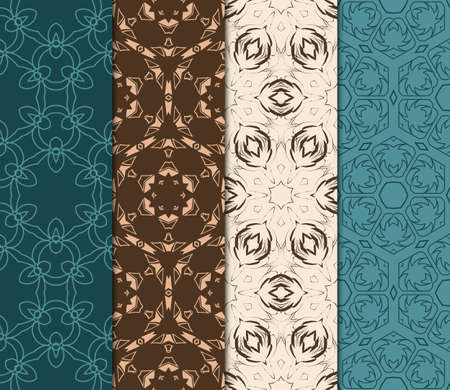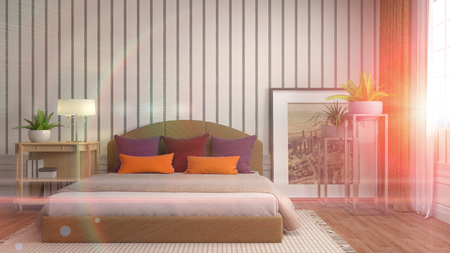Introduction to Cultural Influences on Home Design
American homes are a reflection of the diverse cultural backgrounds of their owners. The colors and patterns used in interior design often carry deep cultural significance, influenced by heritage, traditions, and regional preferences. Understanding these influences can help homeowners create spaces that feel personal and meaningful.
The Role of Cultural Heritage in Color Choices
Different cultures have unique associations with colors. These associations shape the way people decorate their homes, influencing everything from wall paint to furniture and decor accents. Below is a general guide to how various cultural backgrounds influence color preferences in American homes:
| Cultural Influence | Common Accent Colors | Symbolism |
|---|---|---|
| Asian | Red, Gold, Black | Prosperity, Luck, Elegance |
| Mediterranean | Blue, White, Earth Tones | Tranquility, Nature, Warmth |
| African | Earthy Browns, Deep Reds, Bold Patterns | Connection to Nature, Strength, Tradition |
| Scandinavian | Whites, Soft Grays, Light Blues | Simplicity, Minimalism, Calmness |
| Latin American | Bright Yellows, Oranges, Greens | Energy, Festivity, Passion |
The Influence of Regional Traditions on Patterns
Apart from color choices, patterns also play a significant role in home design. Many American homes incorporate patterns that reflect specific cultural heritages. Some examples include:
- Navajo Patterns: Often seen in Southwestern-style homes, these geometric designs reflect Native American artistry.
- Moorish Tiles: Found in Spanish-inspired interiors, these intricate tile patterns add elegance and history.
- Paisley Prints: Popular in Indian-influenced decor, paisley adds a touch of global sophistication.
- Tartan Plaid: A nod to Scottish heritage commonly used in traditional American country homes.
- Dutch Floral Motifs: Seen in colonial-style interiors influenced by early European settlers.
The Blending of Cultures in Modern American Homes
A modern trend in American home design is the blending of multiple cultural influences. Homeowners often mix patterns and colors from different backgrounds to create a unique and personalized look. This fusion not only celebrates diversity but also allows for creative expression through interior design.
2. Historical and Regional Influences on Accent Colors
Accent colors in American homes are deeply influenced by historical events and regional characteristics. Different areas of the U.S. have developed unique color palettes based on their cultural heritage, climate, and available materials. Understanding these influences can help homeowners choose accent colors that reflect the character of their region.
Historical Influences on Accent Colors
The history of a region plays a significant role in determining its preferred accent colors. Architectural styles from different periods often dictate color choices, creating a connection between past and present design trends.
Colonial Era (1600s-1800s)
During the Colonial era, homes were often painted with muted earth tones due to the availability of natural pigments. Common accent colors included deep reds, blues, and greens.
Victorian Era (1830s-1900s)
The Victorian era introduced more elaborate and vibrant color schemes. Homes featured rich jewel tones such as burgundy, gold, and forest green, reflecting the ornate architectural details of the time.
Mid-Century Modern (1940s-1970s)
This period emphasized clean lines and bold contrasts. Popular accent colors included mustard yellow, teal, and burnt orange, reflecting the optimism of post-war America.
Regional Variations in Accent Colors
Geographical differences across the U.S. also influence accent color preferences. Climate, natural surroundings, and cultural history all contribute to regional color trends.
| Region | Common Accent Colors | Influences |
|---|---|---|
| Northeast | Burgundy, Navy Blue, Forest Green | Colonial heritage, historic brick buildings |
| Southeast | Soft Pastels, Coral, Sage Green | Warm climate, coastal influences |
| Midwest | Earthy Browns, Deep Reds, Warm Oranges | Agricultural roots, seasonal changes |
| Southwest | Terracotta, Turquoise, Sand Tones | Desert landscape, Native American art |
| West Coast | Cool Grays, Ocean Blues, Natural Greens | Coastal environment, modern design trends |
The Impact of Local Materials on Color Choices
The materials available in a particular region have historically influenced the selection of accent colors. For example:
- Northeast: Brick and stone homes often incorporate deep reds and browns as accent colors.
- Southwest: Adobe-style houses use warm earth tones that blend with the surrounding desert landscape.
- Pacific Northwest: Wood-based architecture favors muted greens and grays to complement the lush forests.
Evolving Trends in Regional Color Preferences
While traditional influences remain strong, modern design trends have introduced new variations in regional accent colors. The rise of minimalist aesthetics has led to an increase in neutral tones like soft grays and beiges across many parts of the U.S., while urban areas often embrace bold pops of color for contemporary appeal.
By understanding how historical and geographical factors shape accent color choices, homeowners can create spaces that honor regional traditions while incorporating modern sensibilities.

Ethnic and Cultural Heritage in Patterns and Textiles
The United States is a melting pot of cultures, and this diversity is reflected in the patterns and textiles found in American homes. From Native American geometric designs to intricate Asian embroidery, ethnic heritage plays a significant role in shaping interior design choices.
Traditional Influences on Patterns
Many American homes incorporate patterns inspired by various ethnic backgrounds. These designs not only add visual interest but also tell a story about cultural traditions and craftsmanship.
| Cultural Influence | Common Patterns | Popular Textile Uses |
|---|---|---|
| Native American | Geometric motifs, tribal symbols | Rugs, wall hangings, upholstery |
| African | Kente cloth patterns, mud cloth designs | Pillows, throws, tapestries |
| Mexican | Zigzag patterns, floral embroidery | Cushions, table runners, blankets |
| Asian (Chinese & Japanese) | Bamboo prints, cherry blossom motifs | Drapes, bedding, wallpaper |
| Mediterranean | Mosaic tile patterns, intricate florals | Ceramic tiles, curtains, furniture fabrics |
The Role of Handcrafted Textiles in Home Design
The use of handcrafted textiles in home décor adds authenticity and a sense of heritage. Many homeowners seek out handmade rugs, embroidered cushions, and woven wall hangings to celebrate their cultural roots while enhancing their interiors.
Sourcing Ethnic Textiles for Modern Homes
With the rise of global trade and online shopping, it has become easier than ever to find authentic textiles from different cultures. Many designers incorporate these elements into contemporary spaces to create a unique fusion of tradition and modernity.
Tips for Incorporating Cultural Patterns Thoughtfully
- Select pieces that complement your existing color scheme.
- Avoid overloading a space with too many different cultural patterns—balance is key.
- If using bold ethnic prints, pair them with neutral or solid-colored furniture.
- Consider handmade items for an authentic touch that supports artisans globally.
- Mix traditional textiles with modern furnishings for a fresh yet meaningful look.
Cultural influences on patterns and textiles allow homeowners to express their heritage while creating visually rich interiors. Whether through small accent pieces or large statement rugs, ethnic designs continue to shape American home décor in exciting ways.
4. Modern Trends and Multicultural Influences
As globalization continues to shape design trends, American interiors are becoming more diverse, integrating cultural elements from around the world. Modern homes now embrace a mix of traditional and contemporary styles, creating unique spaces that reflect a blend of global influences.
Blending Cultural Elements in Modern Interiors
Today’s American homes incorporate cultural patterns, textiles, and accent colors inspired by different regions. Homeowners are increasingly drawn to designs that celebrate their heritage or favorite travel destinations, making interiors feel more personal and globally connected.
Popular Multicultural Design Influences
| Cultural Influence | Common Accent Colors | Patterns & Textiles |
|---|---|---|
| Mediterranean | Deep blues, warm terracotta, golden yellows | Mosaic tiles, intricate floral motifs |
| Scandinavian | Muted grays, soft whites, pastel blues | Minimalist geometric patterns, natural textures |
| African | Earthy browns, rich oranges, bold reds | Tribal prints, handwoven fabrics |
| Asian (Japanese & Chinese) | Naturals like beige and wood tones with pops of red or black | Simplicity in design, calligraphy-inspired prints |
| Latin American | Lively greens, bright pinks, deep blues | Tropical motifs, vibrant tile work |
The Role of Globalization in Interior Design Trends
The rise of social media and online shopping has made it easier for homeowners to access decor from different cultures. Many interior designers now blend international styles to create eclectic yet cohesive spaces. This trend allows for a fusion of cultural elements while maintaining the functionality and aesthetics of modern American homes.
Sustainable and Ethical Cultural Decor Choices
An increasing number of homeowners are also choosing ethically sourced decor items that support artisans from different parts of the world. Handcrafted rugs from Morocco, hand-painted ceramics from Mexico, and eco-friendly bamboo furniture from Asia are just some examples of how global craftsmanship is influencing American interiors.
The Future of Multicultural Interior Design in America
The trend toward multicultural influences in American homes is expected to continue growing. With an emphasis on inclusivity and appreciation for global artistry, modern interiors will likely feature even more diverse color palettes and patterns inspired by cultures worldwide.
5. Balancing Tradition and Contemporary Styles
Blending traditional cultural elements with modern aesthetics in home design can create a unique and meaningful space. Homeowners and designers often face the challenge of maintaining cultural identity while ensuring that the space feels fresh and contemporary. By carefully selecting accent colors, patterns, and textures, it is possible to achieve a harmonious balance between tradition and modern style.
Using Accent Colors to Bridge Old and New
Accent colors play a crucial role in merging traditional influences with modern design. Many cultures have signature colors associated with their heritage, such as deep reds in Chinese interiors or earthy terracottas in Southwestern designs. By incorporating these tones into a neutral or minimalist setting, homeowners can honor their roots while keeping the space visually updated.
Examples of Traditional Colors in Modern Spaces
| Cultural Influence | Traditional Color | Modern Application |
|---|---|---|
| Chinese | Red & Gold | Accent wall, throw pillows, artwork |
| Mediterranean | Cobalt Blue & White | Kitchens, tile backsplashes, decorative ceramics |
| Southwestern | Terracotta & Turquoise | Potted plants, rugs, furniture upholstery |
| African | Browns & Oranges | Baskets, woven textiles, wood carvings |
Patterms That Blend Cultures with Contemporary Design
The use of patterns is another way to integrate cultural elements into a modern aesthetic. Geometric patterns from Moroccan designs or floral motifs from Indian textiles can be incorporated subtly through rugs, wallpapers, or upholstery. The key is to balance bold patterns with solid colors to avoid overwhelming the space.
Tips for Mixing Patterns with Modern Interiors
- Select One Focal Pattern: Choose one dominant pattern and keep other elements neutral.
- Mimic Traditional Designs in Small Accents: Use patterned cushions, throws, or lampshades instead of large furniture pieces.
- Create Balance with Simple Backgrounds: Pair intricate designs with solid-colored walls or furnishings.
- Lessen Visual Clutter: Avoid mixing too many different patterns in one space.
The Role of Materials and Textures
Apart from colors and patterns, materials and textures also help bridge the gap between tradition and contemporary styles. Natural materials like wood, stone, or woven fabrics are common in many cultural traditions and can be used in modern furniture and decor to maintain authenticity while embracing current trends.
Sustainable Choices for a Timeless Look
Sustainable materials that reflect cultural heritage are becoming more popular in American homes. For example:
- Bamboo: Common in Asian-inspired designs; great for flooring or furniture.
- Terracotta Tiles: A nod to Mediterranean and Southwestern styles; ideal for warm-toned interiors.
- Linen & Cotton: Often found in European country-style homes; works well for curtains or upholstery.
- Naturally Dyed Textiles: Inspired by African or South American traditions; perfect for rugs and tapestries.
A Personalized Approach to Blending Styles
The most successful home designs are those that reflect personal experiences and cultural backgrounds while staying functional for modern living. Whether through color choices, patterns, or materials, blending traditional influences with contemporary aesthetics allows homeowners to create spaces that feel both timeless and relevant.

